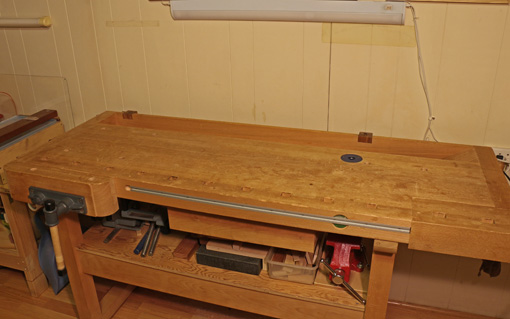
A project idea has taken hold, a concept has developed, and maybe you even have scale drawings. This could come to fruition but your jointer isn’t wide enough or your bandsaw isn’t tall enough. Or the boards you found for the project aren’t quite consistent in color and figure. Or your shop isn’t big enough, or you don’t have a real shop at all. And you really don’t have the time anyway.
It’s always something.
Always, because making real things is done in the real world with all its unsavory limitations. The wood is never quite right. There is always one more tool that would probably make the work a breeze. A wide belt sander? Sure, that will solve everything. Everything, that is, until the next limitation comes along.
Make it anyway. It won’t be perfect or just the way you want it, but it will be. Until then, it is nothing.
Let’s take an example from music history. What do you do if you are an organist renowned throughout Europe, later to be recognized as one of the greatest composers in history, you basically get canned from your job and move to a place where you have no access to an organ? It must have been like a woodworker with no planes! Well, I guess if you are Johann Sebastian Bach, you deal with the limitations and use the resources available to you to make stuff like this:

Nearly 300 years later, the lack of a right hand does not stop Adrian Anantawan from playing these works. [The sample heard in most of the clip is from Partita #3 in E for solo violin, 3rd movement.]
So, what then, when the work is done? If the piece is the product of a sincere effort, it becomes its own point of reference, freed from the maker’s expectations, limitations, and nervous influence. Never perfect, but excellent, good, or just fair, it is nonetheless now on its own.
It is too late for substantive changes. This is just as well, because now everything hopefully seems right unto itself, at whatever level the work was done, including the imperfections and doubts, almost as if it was meant to be that way.
Deal with limitations, do the best you can, and accept the result for what it is. Make something.
It’s always something – until the thing is.


Thanks, for years I’ve thought along those same lines, even more the small imperfections, not sloppiness or lack of caring, but the imperfections that come from making things by hand are what makes Art.
The dreaming is easy, the sweating ain’t.
ken
FABULOUS Rob!!!
You’re exactly right. Get working, even if you don’t have exactly the right tools, exactly the right materials, or the perfect 2mm twine for your bow saw.
As one ages, you come to realize that life is too short to wait for all the planets to be perfectly aligned before doing anything.
I’ve got this simple little pine box I made. It’s a decent box, but the material is some of that stuff from NZ which is stringy. My boxes are usually platforms for carving. This one, I thought would be a simple storage box for some card scrapers, left plain and simple. But, … why not? I’m going to carve a 3 leaf motif on the lid today, despite it being stringy, raggedy pine.
Impressive violinist too!
THANKS for the encouragement. I hope more people take it to heart.
The first blog I read this morning and the best I’ll read today. Two days ago I shipped a carefully made box to a friend, done with admiration and affection, but only modest talent. “Right unto itself” it is though. Thank you.
Nice post Rob.
I’m in the middle of facing one of those somethings right now.
I’m building a bench for the entry way in my house. I am using ash, of which I had two stashes. I was able to source all the parts for the frame and back of the bench from one stash, but just don’t have enough for the seat slats. So I’ll have to use the other stash for that. The color and grain are quite different though. I have options: a) use it for the slats as is, b) veneer it with what is left of the first stash, c) a or b plus stain. In the end it might not be as “perfect” as in my head, but as you said, it will be, and that’s what counts.
K.M., Bob, Bruce, and Dave, thanks for the comments and kind words. Woodworking is mostly a solitary pursuit so it is encouraging when our thoughts resonate.
Rob